Recruits’ futures begin to take shape as they receive duty assignments
Week 19: Nov. 19-25, 2017
It could have been just another piece of paper. After 19 weeks of training, recruits have seen more than their share of them. Everything from exam results to physical fitness reports and inspection infractions have been recorded 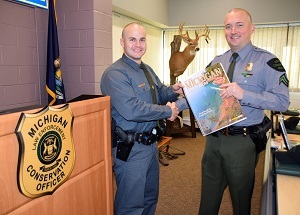 meticulously by instructors on various cards and forms. meticulously by instructors on various cards and forms.
Not that those papers haven’t been a critical part of recruits’ development. But this particular sheet was special. It didn’t dwell on past successes or mistakes. It was about their futures.
The class was anxious as 1st Lt. Steve Burton strode to the rostrum and placed the paper on top. Lt. Burton, training section supervisor for the Department of Natural Resources Law Enforcement Division, was about to reveal which county each trainee will be assigned to live and work in after graduating DNR Conservation Officer Recruit School next month.
The lieutenant went down the list, naming each recruit and his or her new home county. It was like an early Christmas present. For these young men and women, it was an exciting lead-in to their Thanksgiving holiday weekend. Receiving their assignments was a validation of the tremendous amount of effort they’ve put in. It is tangible proof that their 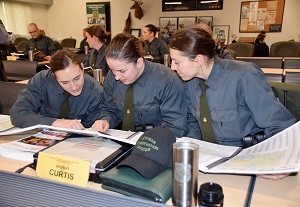 work is paying off and their futures are taking shape. work is paying off and their futures are taking shape.
DNR conservation officers pioneered the concept of community policing. As members of Michigan’s oldest statewide law enforcement agency, conservation officers live and work in the counties they serve, which is one key reason for their effectiveness. Protecting an area’s families and natural resources requires conservation officers to know their communities inside and out. It can’t be done from a distance. Knowing the people, terrain and back roads comes from being part of the community. In addition to their training and dedication, being community-based is a big reason conservation officers have a distinguished record of protecting Michigan’s natural resources and saving lives.
Learning never stops
Learning never stops at the academy. Even with the midweek excitement of finding out their county assignments, recruits still found the first half of the week packed with classroom work and practice scenarios.
Monday’s classes started with a visit from Derek Wicklund, an officer with the Green Bay (Wisconsin) Police Department. Wicklund, brother of Sgt. Jason Wicklund, Recruit School commander, is a nationally certified drug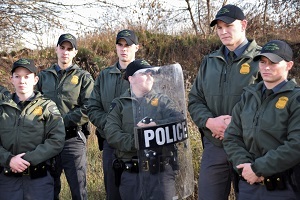 recognition expert who shared his expertise on narcotics enforcement. Conservation officers patrol remote areas that sometimes are frequented by drug users and producers. The ability to identify the illegal activities and substances is important for the safety of conservation officers, and for enforcing the law. Recruits learned to identify common substances that can be abused unlawfully. They also were taught techniques in identifying impairment by drugs as opposed to alcohol impairment. recognition expert who shared his expertise on narcotics enforcement. Conservation officers patrol remote areas that sometimes are frequented by drug users and producers. The ability to identify the illegal activities and substances is important for the safety of conservation officers, and for enforcing the law. Recruits learned to identify common substances that can be abused unlawfully. They also were taught techniques in identifying impairment by drugs as opposed to alcohol impairment.
The class then moved on to instruction about controlling civil disorder by Michigan State Police 1st Lt. Brody Boucher. Recruits were introduced to gas masks and other riot control gear. While riot control isn’t a primary role for conservation officers, they are fully sworn law enforcement officers who may be called upon to assist other police agencies with crowd control.
Receiving the same training as their counterparts makes conservation officers a real asset. “It’s important for officers around the state to have standardized training,” Lt. Boucher said. “In a riot situation, officers from several agencies could be put together and can move as a cohesive unit in protecting the public and bringing an end to the conflict.”
Preparing for the field
Tuesday morning’s physical training gave the class a taste of what to expect in the field. Recruits performed relay races while dragging a deer carcass, carrying canoes, and even carrying canoes with a deer carcass inside. They also 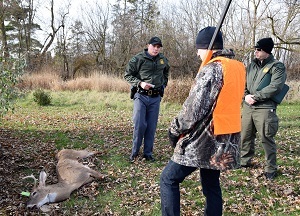 performed exercises of loading the deer carcass into the bed of a patrol truck. Physical training like this prepares recruits for essential job functions they must perform in the field. performed exercises of loading the deer carcass into the bed of a patrol truck. Physical training like this prepares recruits for essential job functions they must perform in the field.
Positive public contacts
Later in the day, recruits set out on mock patrols while being monitored by a ride-along proctor. Under the scenario, they encountered a successful deer hunter dragging his fresh harvest into a parking area. Recruits were to contact the hunter, identify themselves, and verify the legality of the hunter’s weapon and the deer license that was validated and attached to the deer. Recruits were surprised to find that there were no violations present in the scenario.
“It’s important recruits understand that most of our contacts with the public are very positive and the vast majority of those contacts will not involve a violation,” said Conservation Officer Shane Webster.
Recruits congratulated the hunter on his success and offered to help drag the deer to the vehicle and load it.
Recruits then faced a second scenario in which they encountered a vehicle operating without a working brake light. 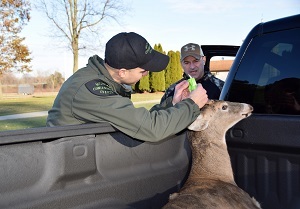 Once the traffic stop was made, recruits noted a tagged deer in the truck bed. The driver told recruits the deer was taken on opening day of deer season, Nov. 15. But after checking the tag, recruits quickly learned it did not belong to the operator of the vehicle. The driver would protest and accuse the recruit of making too big a deal of it. Once the traffic stop was made, recruits noted a tagged deer in the truck bed. The driver told recruits the deer was taken on opening day of deer season, Nov. 15. But after checking the tag, recruits quickly learned it did not belong to the operator of the vehicle. The driver would protest and accuse the recruit of making too big a deal of it.
“It actually is a big deal,” explained Conservation Officer Troy Van Gelderen. “Conservation offers often find people loaning and borrowing tags from one another. If that activity is allowed, it isn’t long before several people are hunting but only one tag is purchased.”
Recruits ended the scenario by seizing the deer and the firearm used to take it. They also issued appropriate charges.
Always on guard
Tuesday evening’s focus was on terrorism awareness, with an emphasis on domestic and international terrorism. Recruits were taught to identify locations within their communities and across the state that may be potential targets of terrorism. It is essential that law enforcement officers become familiar with these locations to protect the public in the event of a terror attack.
Future takes shape
Recruits were pleasantly surprised Wednesday morning they there were told to report to the classroom for their county assignments. It was a big moment as they learned where they will start their careers.
“There is no bad county to be assigned to in Michigan and that’s part of what makes our state so great,” Lt. Burton 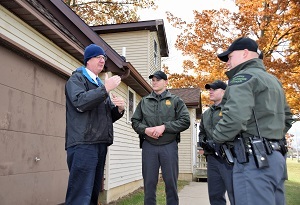 said. said.
Recruits were issued county atlases so they can begin familiarizing themselves with their new homes. After 19 extremely demanding weeks, receiving their county assignments assured trainees there is light at the end of the tunnel. But they’ve been here long enough to know there are still hurdles to clear.
Search and seizure
One of the hurdles was additional training on requesting and executing search warrants. Under the guidance of retired Michigan State Police inspector Dave Greydanus, recruits used the “signed” mock search warrants they had written and submitted in an earlier class.
The scenario had recruits searching a home within the legal bounds of their search warrants to discover a deer being cut up in a garage. They also recovered the firearm used to illegally take the deer. The class learned that obtaining a 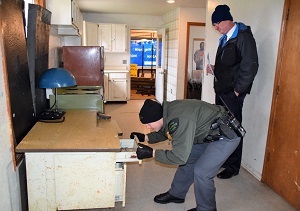 search warrant signed by a judge is required by law to protect a citizen’s right to privacy. Learning to perform a legal, safe and effective search will serve the recruits well in their careers as conservation officers. search warrant signed by a judge is required by law to protect a citizen’s right to privacy. Learning to perform a legal, safe and effective search will serve the recruits well in their careers as conservation officers.
Cases often are decided by the evidence that can be gathered. When probable cause exists, obtaining a search warrant can help officers obtain that crucial evidence. Recruits also learned that relevant evidence is admissible in court. Their training covered the importance of knowing that information, statements and evidence can be used lawfully in a court case. Having that understanding not only will help the future conservation officers in gathering evidence, but it will help them build rapport with their judicial counterparts in their area courthouses.
Giving thanks
It was a short three-day work week due to the Thanksgiving holiday, which gave recruits and instructors a well-earned break from the academy’s countless stresses and demands. For instructors, it was a brief but welcomed reprieve from the enormous responsibilities that come with sculpting 22 young lives. For the men and women of Recruit School #8, it was a time to reflect on their growth as people and professionals while they pursue their career goals. They have a lot to be thankful for – and a lot to look forward to.
Subscribe to the weekly conservation officer academy blog, which also will be posted on the Michigan DNR Facebook page. View previous blogs from Recruit School #8.
/Note to editors: Accompanying photos are available below for download. Caption information follows.
Tag_check: A recruit practices checking a deer tag to make sure it is in possession of the rightful owner. Conservation officers find people who sometimes loan their deer tags to others, in violation of the law.
On_patrol: The majority of interactions between conservation officers and the public do not involve violations. Pictured, a recruit walks through a training scenario in which he greets a successful hunter who followed the rules. After seeing no violations, the recruit offers to help the hunter drag the deer and load it on a truck.
Bright_futures: Recruits compare notes with each other after being told of the areas in which they will be assigned to live and work upon graduation. Conservation officers live in the counties in which they work, which is one reason for their success in protecting Michigan’s natural resources and citizens.
Proper_procedures: Conservation officers must know how to obtain criminal evidence while respecting a citizen’s right to privacy. Pictured, retired Michigan State Police inspector Dave Greydanus coaches recruits on proper search warrant procedures before they conduct a mock home search.
Looking_ahead: Cpl. Patrick McManus, right, assistant commander of Recruit School #8, congratulates a trainee who received his new duty assignment. Recruits learned the counties in which they will begin their careers after graduating from the academy in December.
Keeping_the_peace: Conservation officer recruits listen intently and familiarize themselves with protective gear during training on maintaining order during civil disturbances. As fully sworn law enforcement officers, conservation officers may be called upon to assist other agencies in keeping peace during an incident of civil unrest.
Conducting_a_search: A conservation officer recruit scours a home for evidence as he practices executing a search warrant under the supervision of retired Michigan State Police inspector Dave Greydanus./
The Michigan Department of Natural Resources is committed to the conservation, protection, management, use and enjoyment of the state’s natural and cultural resources for current and future generations. For more information, go to www.michigan.gov/dnr.
|

 meticulously by instructors on various cards and forms.
meticulously by instructors on various cards and forms. work is paying off and their futures are taking shape.
work is paying off and their futures are taking shape. recognition expert who shared his expertise on narcotics enforcement. Conservation officers patrol remote areas that sometimes are frequented by drug users and producers. The ability to identify the illegal activities and substances is important for the safety of conservation officers, and for enforcing the law. Recruits learned to identify common substances that can be abused unlawfully. They also were taught techniques in identifying impairment by drugs as opposed to alcohol impairment.
recognition expert who shared his expertise on narcotics enforcement. Conservation officers patrol remote areas that sometimes are frequented by drug users and producers. The ability to identify the illegal activities and substances is important for the safety of conservation officers, and for enforcing the law. Recruits learned to identify common substances that can be abused unlawfully. They also were taught techniques in identifying impairment by drugs as opposed to alcohol impairment. performed exercises of loading the deer carcass into the bed of a patrol truck. Physical training like this prepares recruits for essential job functions they must perform in the field.
performed exercises of loading the deer carcass into the bed of a patrol truck. Physical training like this prepares recruits for essential job functions they must perform in the field. Once the traffic stop was made, recruits noted a tagged deer in the truck bed. The driver told recruits the deer was taken on opening day of deer season, Nov. 15. But after checking the tag, recruits quickly learned it did not belong to the operator of the vehicle. The driver would protest and accuse the recruit of making too big a deal of it.
Once the traffic stop was made, recruits noted a tagged deer in the truck bed. The driver told recruits the deer was taken on opening day of deer season, Nov. 15. But after checking the tag, recruits quickly learned it did not belong to the operator of the vehicle. The driver would protest and accuse the recruit of making too big a deal of it. said.
said. search warrant signed by a judge is required by law to protect a citizen’s right to privacy. Learning to perform a legal, safe and effective search will serve the recruits well in their careers as conservation officers.
search warrant signed by a judge is required by law to protect a citizen’s right to privacy. Learning to perform a legal, safe and effective search will serve the recruits well in their careers as conservation officers.




